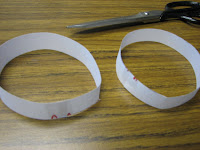The 19th-century mathematician August Möbius was born on this day in 1790. Möbius was responsible for a number of things in geometry, topology, and number theory, but he’s best known for the Möbius strip, a puzzling and endlessly fascinating entity that happens to be 150 years old this year.[1]
A Möbius strip is a two-dimensional object that, when viewed in three-dimensional space, has only one side. What’s that mean? Let’s make one, using paper to approximate a two-dimensional object (we’ll ignore the thickness of the paper).
Take a standard sheet of paper and cut a 3 cm (or 1 inch) strip off of a long edge. Of course, it has two sides. On one side, which we’ll call side A, write the letter “A” on each end, like this:

Turn it over to what we’ll call side B, and write the letter “B” on each end, similarly. 
Pick up the strip and put the two short ends together so that the two letters “A” meet and the strip forms a ring, a band. Tape it together, as you see to the right.

The pen will have traced a line around side A of the band. Side B will be blank. That’s all as we’d expect.


That can be a little hard to get one’s head around, so think about it a while.
A fun thing to do with a Möbius strip is to cut it down the middle, a handy thing now that we have a line to cut along. 
Now do the same with the Möbius strip. What happens?

A reminder: the paper band is a model of a Möbius strip, using the paper to approximate a two-dimensional object. A true Möbius strip has no thickness, and exists only theoretically.
A similar concept is the Klein bottle: a two-dimensional object that can be thought of as a tube without distinct “inside” and “outside” surfaces — the inside and outside are one, much as side A and side B of the Möbius strip become one. A Klein bottle, too, exists only theoretically, and can’t even be modelled in three-dimensional space (modelling it requires four dimensions).
Topology is such fun!
[1] Sesquicentennial, from sesqui, Latin for “one and a half”, and centennial, “100th anniversary”.







1 comment:
This is a cool post, thanks! You're right that it is the sesquicentenial of the Möbius band, but it was actually discovered by Listing and not Möbius (http://www.maa.org/mathland/mathtrek_7_10_00.html). According to their letters, it looks like Listing beat Möbius by a few months. (Listing was the mathematician who coined the term topology.)
Post a Comment